How do you even consider Halo Infinite in totality? Not just any Halo game but this Halo game — one that was supposed to herald a new generation of Xboxes but was delayed out of the launch window; one that’s had no shortage of public scrutiny over its tumultuous development process; one that’s not even out yet but has already been the centrepiece of multiple internet-dominating conversations; and, most crucially, one that’s meant to revitalize a totemic first-person shooter series after a stretch of metabolic dormancy. There are so many expectations on Halo Infinite’s armour-clad shoulders that you’d think it’d crumble apart in a pile of pixels. Every single player is bound to come into this game with their own predetermined definition of what it is and what it stands for. I sure as hell did.
So, yeah, let’s just get the easy part out the way:
[review heading=”Halo Infinite” image=”https://www.gizmodo.com.au/wp-content/uploads/sites/3/2021/12/06/6e43ec6abb6c4994a05cd055e0f42fb4.jpg” label1=”Back-of-the-box quote” description1=””So much for finishing the fight…” – Kotaku.com” label2=”Type of game” description2=”Halo: The Greatest Hits (2001-2021)” label3=”Liked” description3=”Pretty much everything except for the villain(s) and the absent co-op.” label4=”Disliked” description4=”The villain(s), the encounters that feel designed for co-op.” label5=”Developer” description5=”343 Industries” label6=”Platforms” description6=”Xbox One, Xbox Series X (played), Xbox Series S, PC” label7=”Release date” description7=”December 8, 2021 (the multiplayer mode hit on November 15) ” label8=”Played” description8=”11 hours to hit the credits with 33 per cent completion, but it’s likely longer in real time, since the clock reverts upon death; a further 61 hours in multiplayer.” ]
Halo Infinite, officially out on Wednesday for Xbox and PC, is the seventh mainline Halo game and the first in six years, following 2015’s divisive Halo 5: Guardians. Infinite picks up roughly a year and a half after the events of Halo 5, but doesn’t concern itself with those events beyond some perfunctory, and intermittent, moments of exposition. And in a departure from that game’s most notorious misstep, Halo Infinite’s story is told entirely from the perspective of longtime series hero Master Chief.
Playing the whole game as Mr. John Halo himself makes Halo Infinite feel less like a proper sequel to Halo 5 and more like a follow-up to the venerable original trilogy, when the series was under the purview of Bungie. At times, it plays like a greatest hits album of iconic setpieces from Halo, Halo 2, and Halo 3 (which tracks, seeing as Joseph Staten, an instrumental creative force behind Bungie’s trilogy, was brought in last August to help carry Halo Infinite over the finish line). You are, once again, a seven-foot-tall supersoldier palling around with a vivid blue artificial intelligence on a ring-shaped space station, hoping to save the galaxy from zealously religious extraterrestrials. We’ve all seen Hollywood bungle fan service. Halo Infinite nails it by including winks and nods for more than the sake of winking and nodding. These moments are genuinely thrilling on their own merits, and never overstay their welcome. Fan service is, apparently, more fun when you can actively engage with it.
But even if you’re squarely in the “What’s a Halo?” camp, there’s a whole lot to like about Halo Infinite. The shooting is a blast, thanks to a deep bench of enemy classes and an even deeper arsenal of creative weapons, supplemented by a Bond-worthy kit of toys to play with; key among them is a grappling hook, an item that, frankly, should just be in every video game. Amid a trend of open-world games valuing quantity over quality — of tossing the player into worlds cluttered with bland, repetitive tasks — Infinite’s open-world section feels refreshingly focused. All this, plus it’s more polished than most games created at this scale. And, to finally put to bed last year’s infamous graphics debacle (hi, Craig), Infinite is stupefyingly gorgeous.
In other words, the question isn’t if Halo Infinite is any good. It is. What’s most worth measuring here is twofold: Was it worth the wait? And does this mean Halo is really, truly back?
Of course, the expected wait for Halo Infinite was unexpectedly slashed by several weeks. You probably already know the broad strokes: On November 15, the 20th anniversary of Halo: Combat Evolved, developer 343 Industries surprise-released Infinite’s multiplayer mode on Xbox and PC ahead of its planned December 8 debut. It’s technically “a beta,” but c’mon, can you name a recently released beta as smooth? Plus, you can already spend hundreds of dollars of very real real-world money on it. Make no mistake: Halo Infinite is already out.
In fact, you may have already spent many (many) units of life’s most ephemeral currency, time, playing it. Halo Infinite’s multiplayer mode, in a first for the decades-old series, is wholly free-to-play. (The campaign is available for a standard $US60 ($86) or as part of a $US10 ($14)-a-month Game Pass subscription.) As with most games based on such a model, you can supplant your avatar, a 26th-century supersoldier known as a Spartan, with various cosmetic options that cost varying amounts of actual money. That’s in addition to an industry de rigueur battle pass, which begets sweeter and more frequent rewards if you spring for the premium version.
The entire model has sparked some cacophonous feedback, to which 343 Industries has introduced marginal changes in response, an ever-evolving process unfolding in real time that we’ve documented extensively here at Kotaku. If there’s debate to be had about Halo Infinite’s multiplayer portion, you’ll find it there, squarely on its progression system and cosmetic offerings. Infinite’s fundamentals — the guns, the gear, the maps, the modes — have received near-universal praise, a dominant opinion I’m in personal lockstep with.
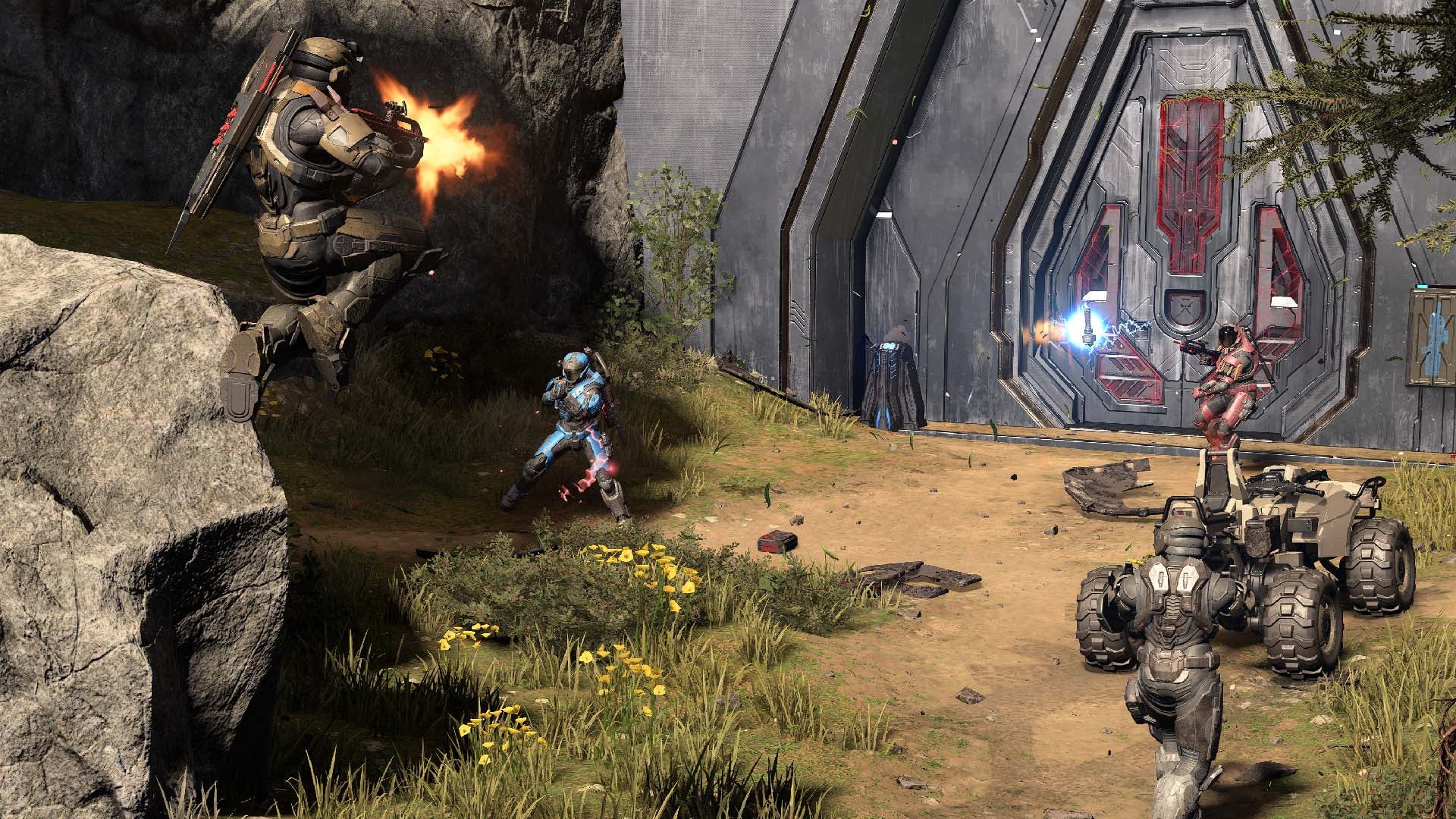
Multiplayer shooters live and die by the strength of their guns. In addition to remixed versions of about a dozen-ish classic Halo firearms, like the rapid-fire assault rifle and burst-fire battle rifle, there are a dozen-ish more that are totally new to the series. A single-shot sniper rifle fires spike projectiles that kill enemies in one hit, even if you nail someone in the foot; another shoots electric rounds strong enough to short out tanks. Most of these weapons, save for one — a functionally useless pea shooter called the ravager — are balanced to the point where you always have a fighting chance. Halo Infinite’s multiplayer is structured such that, more often than not, victory is within grasp.
Yes, there are some notable foibles (right now, for instance, you cannot choose to play deathmatches and only deathmatches, and the options for custom games are a pittance) but nothing that qualifies as a deal-breaker.
For a broader critique of Halo Infinite’s PvP and a deep dive into what it does (and doesn’t) do right, I’d urge you to check out Stella Chung’s thorough multiplayer review over at IGN. Let me just leave you with one point: There’s a uniquely Halo conundrum — it’s late, you’re getting tired, you play one last match, you run the table, which feels awesome, so you say “screw it” and play another round, but you totally flop, and you obviously can’t go to bed all pissed off, which, uh-oh, now you’re stuck in an ouroboros cycle that keeps you up ‘til dawn (worth it) — that was absent in the two recent Halo games. It is unequivocally present in Halo Infinite. My eyes, they’re so bleary. They have been for weeks.
Halo Infinite’s campaign opens cold with Master Chief getting his arse absolutely handed to him. The UNSC Infinity, the human flagship that serves as a base of operations in Halo 4 and Halo 5, is stormed by a splinter faction of Covenant forces known as the Banished. (This faction plays a role in the 2017 real-time strategy game Halo Wars 2.) Their leader, a Brute named Atriox, beats the snot out of Chief and then…drops him into space, assuming he’s KIA.
Array
Array
– Array
This, to me, boggled the mind. You’re telling me that the strong and smart leader of a savvy militant group would make the stupidest tactical mistake in history — that he’d just presume the death of all-time badass Master Chief instead of, I don’t know, double-tapping, burning the body, and dropping the ashes in a pool of caustic acid, then inventing an interdimensional transit device and recreating the battle across the multiverse so as to guarantee no possible versions of Chief from any possible reality could come back and seek revenge? Really?
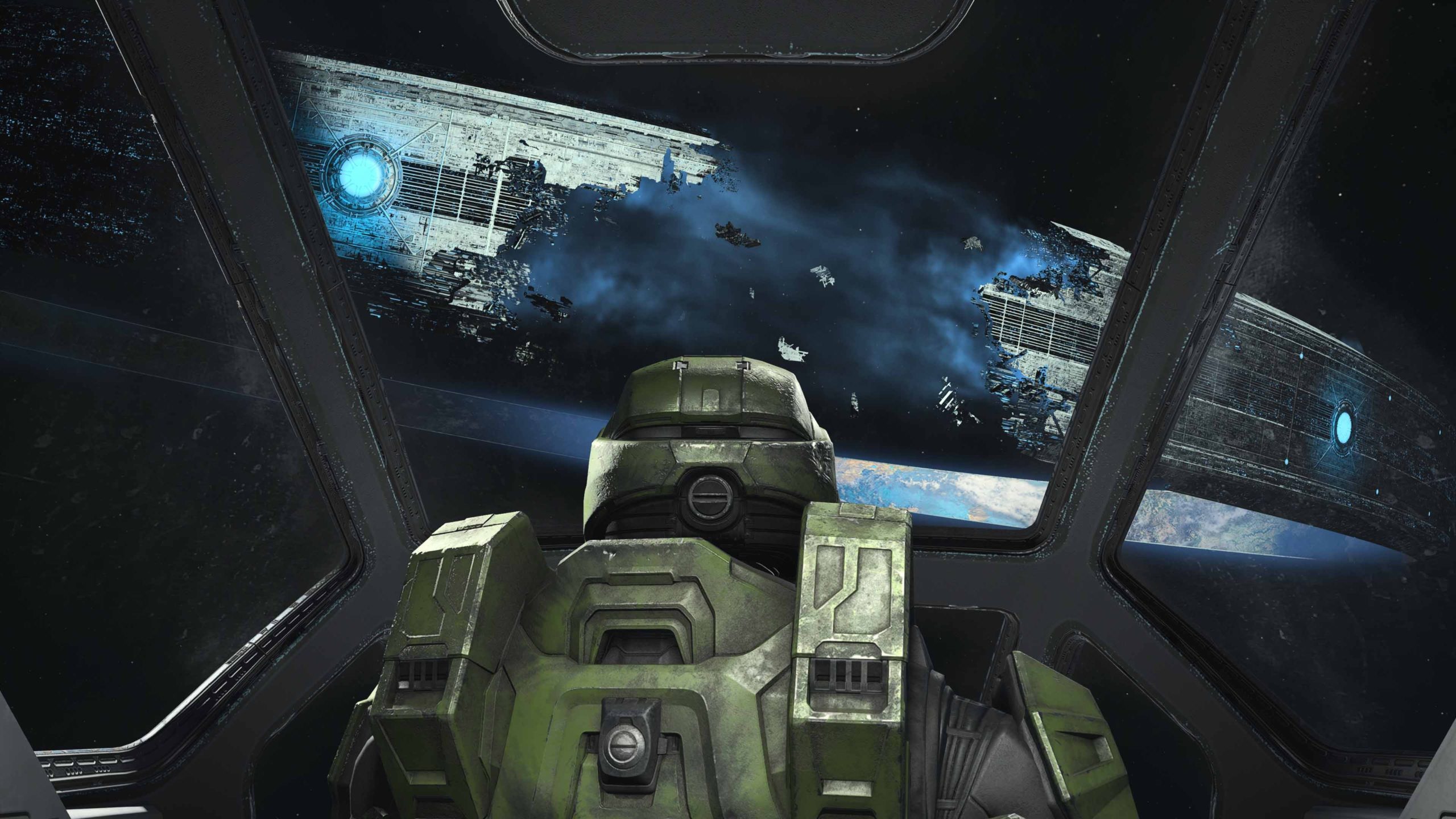
Six months later — and you may have seen this play out in the spine-tingling E3 2019 trailer — Chief, still very much alive but floating unconscious in space, is rescued by a character known only as the Pilot. This enviably bearded man wakes Chief up (in a player-tutorial sequence that’s smack out of Halo 2) and points out what the duo is next to: a Halo ring, shattered at the belt due to unknown reasons. Chief and the Pilot head down to its surface to find an artificial intelligence unit called the Weapon. Apparently, she can help them track down Chief’s prior AI partner, Cortana — who, you may recall, stated an intent to basically commit genocide on a galactic scale at the end of Halo 5.
This intrepid trio comprises the heart and soul of Halo Infinite, what with their penchant for banter and interpersonal dynamics. The Pilot is the grounded one, constantly reacting to Infinite’s abjectly bonkers events with the incredulity and unsteady resolve we’d all surely feel in the same situations. Meanwhile, the Weapon, who was supposed to be deleted prior to the events of Infinite, spends much of her screentime contemplating her existence, why she’s still around, and what plans got fucked up to grant her a second chance at life, giving a zippy and personal thrust of mystery to Halo Infinite.
Master Chief is somewhat more of an enigma than the other two, and is the clear driving force behind the mystery at play. It’s obvious from the jump that, despite you literally spending most of the game behind his eyes, he knows more than he’s letting on. So this presents a bit of dissonance. Chief’s not just hiding his secrets from the Pilot and the Weapon. He’s also hiding them from you.
Microsoft provided Kotaku with a review build of Halo Infinite on the condition that we don’t reveal the “ultimate fate” of any primary characters. I won’t, wouldn’t dream of it, but it’s irresponsible to consider Halo Infinite without acknowledging the serious emotional transformation Chief goes through. In one striking moment, he pulls a move so cold-hearted it’s almost hard to continue playing as him. In others, he’s more human than ever, the cracks in his fancy Mjolnir armour almost showing a real person underneath.
Over the years, Master Chief has (rightfully) gained a reputation as perhaps the quintessential “badass space marine” trope. This is the man, after all, known for such one-liners as “Asking’s not my strong suit,” the man who stoically gives the Covenant back their bomb, the man who unflappably holds duty on a pedestal above all, unless it steps between him and his friends, at which point: watch out.
Halo Infinite, however, stars a Master Chief who’s in touch with his feelings. He often offers salvos of comfort and words of wisdom. At one point, he openly admits to not feeling OK, to legitimately feeling some Master Grief. Can you imagine the stoic badass space marine of the mid-2000s saying as much? Maybe I’m being a bit too optimistic, borderline naive even, but it gave me a glimmer of hope that we’re done once and for all with that particular era of gaming, as myopic and bleak as it was.
So, what do you actually do in Halo Infinite? Pfft, simple: You shoot aliens! Of course, there’s a bit more to it (you sometimes drive vehicles or press “X” to interact with fancy future computers) but that’s the gist.
Unlike every prior Halo game, Halo Infinite isn’t a linear first-person shooter. But it’s not an open-world shooter, either, as some pre-release chatter may have you believe. It occupies a liminal space, both linear and structured, sometimes expansive, sometimes strictly confined. (To sketch out some rough expectations: The cold open is all linear, the middle section plays out in wide-open spaces featuring a raft of optional objectives, and the final act culminates in a several-hour-long series of subsequent linear missions.)
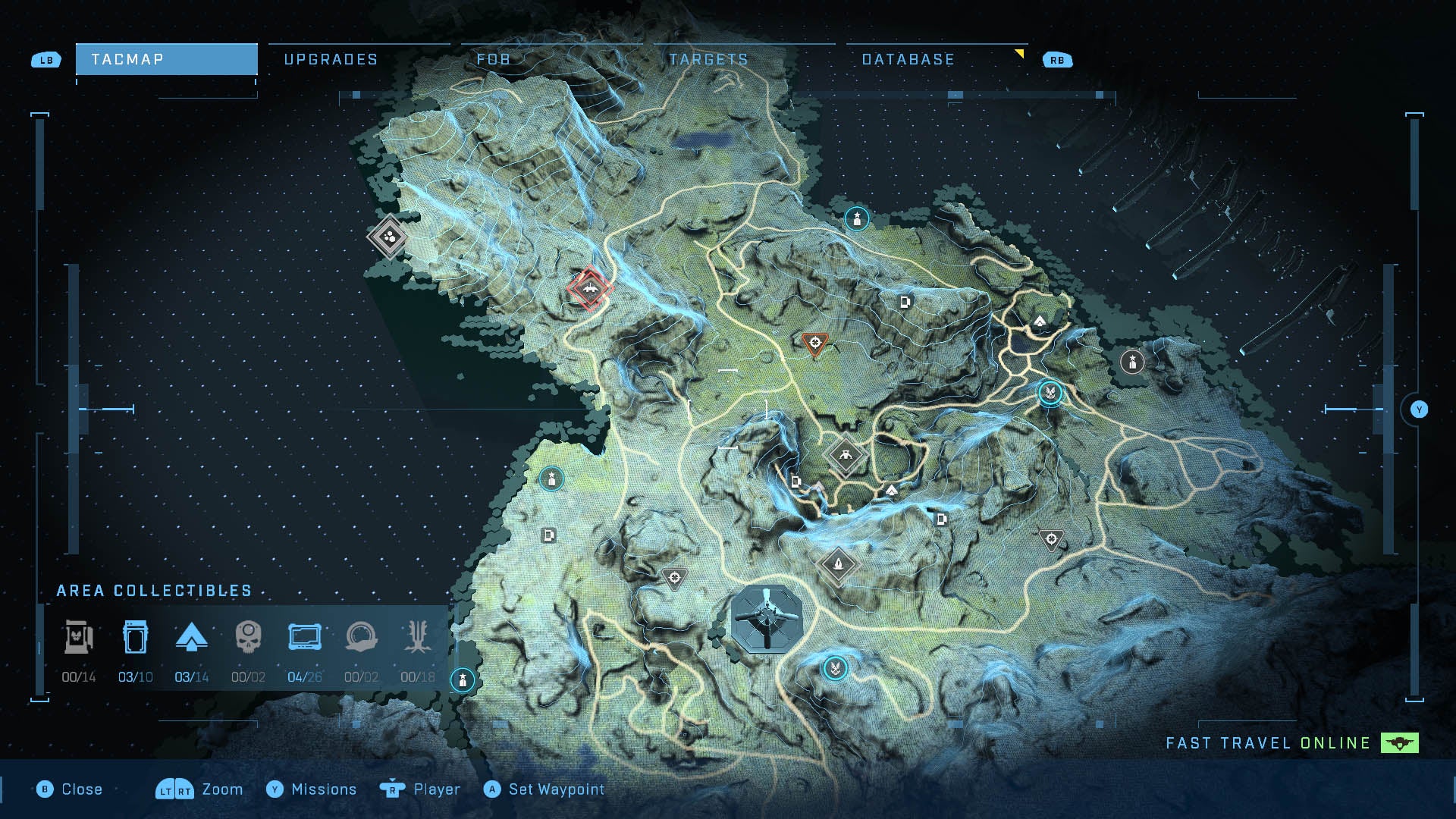
When Halo Infinite stays on rails, it feels like a time machine. Gone are the glistening landscapes of Halo 4 and Halo 5. In their place are levels set among the future-chic Brutalist structures that defined most of the original trilogy. Some combat chambers even seem lifted wholesale from the most timeless stages.
Throughout the dozen-plus main missions, you play through unmistakable callbacks to some of Halo’s enduring setpieces: activating a gravity lift into an alien vessel (“Truth and Reconciliation,” Halo 1), taking out two Hunters in a circular pavilion above an underground facility (“The Silent Cartographer,” Halo 1), surviving swarms of enemies as you ride a gondola across a bottomless chasm (“Regret,” Halo 2), piloting a fleet of destructive vehicles while assaulting an enemy fortress (“The Ark,” Halo 3), awakening a slumbering ancient foe that threatens galactic stability (lmao pick a Halo).
These setpieces are punctuated by a soundtrack, composed in part by Gareth Coker of Ori and the Will of the Wisps, that seamlessly mixes Marty O’Donnell’s ageless score with reimagined takes on the theme. (Infinite also features original compositions.) It’d be a lie to say I didn’t feel instantly whisked back to 2007 when those Halo crescendos kicked in. The nostalgia here is deliriously potent.
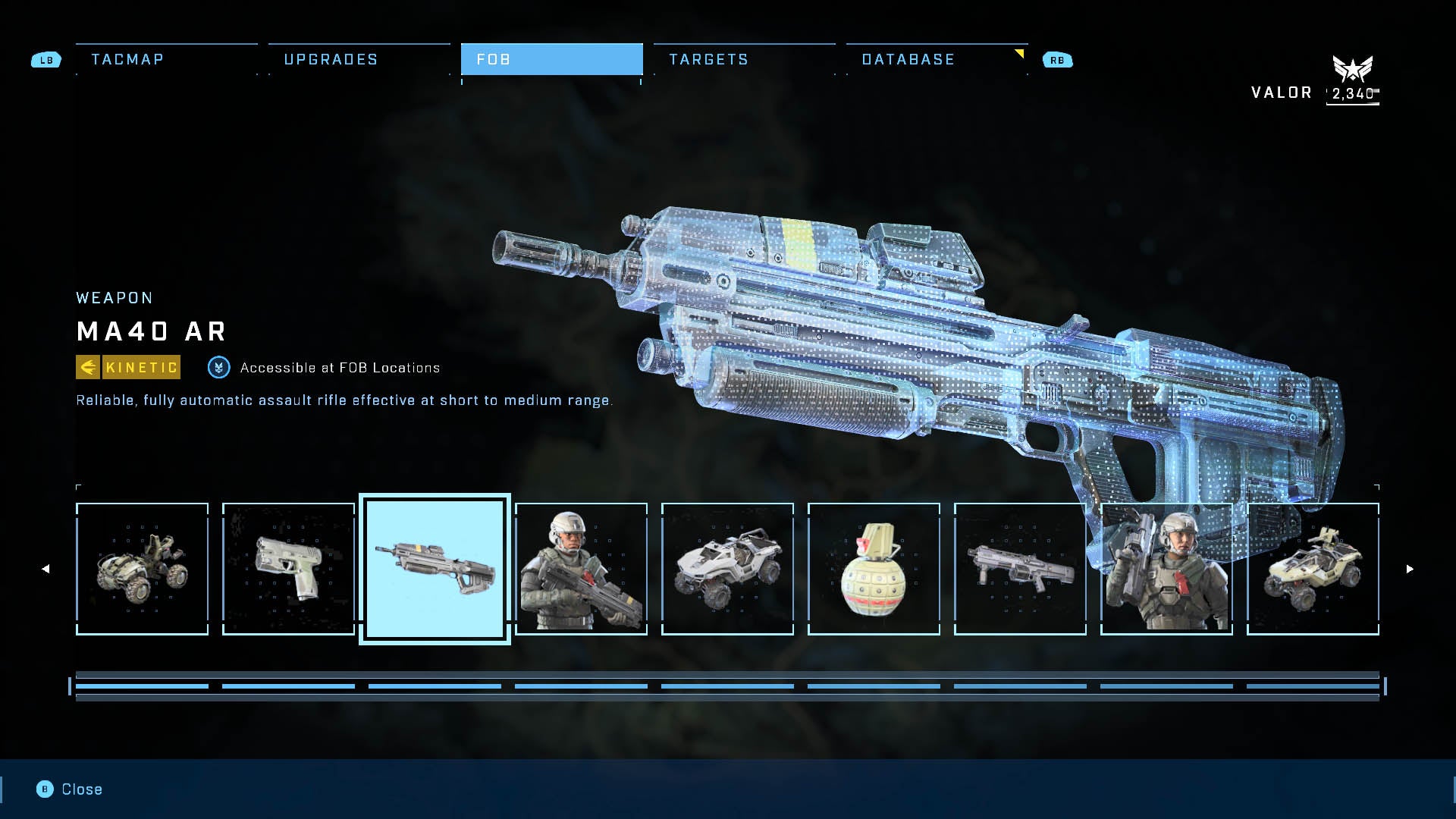
Less familiar are the open segments, though anyone who’s played an open-world shooter will immediately grasp the structure. Between main missions, you can explore at will. You can rescue groups of imprisoned space marines or capture Banished operating bases. You can take out mini-bosses, each replete with their own dossier detailing a gruesome backstory. Completing these tasks grants you a chunk of XP, called Valor; every 100 (sometimes 200) Valor you earn ranks you up, unlocking new guns and other weapons, allowing you to further customise your loadouts at any operating bases you’ve captured. Yes, even Halo Infinite’s campaign has a battle pass of sorts. (It doesn’t cost extra, don’t worry.)
You can further go into explorer mode and hunt down audio logs, which fill in the narrative gaps between Halo 5 and Halo Infinite, or cosmetic options for the multiplayer mode: weapon skins, armour skins, emblems, banners, and the like. I did not see anything on the scale of armour kits. Nor did I see what any of the cosmetic options look like, since the review copy Microsoft provided Kotaku is wholly separate from the widely available multiplayer mode, precluding me from testing them out on my avatar. The review copy will also wipe my save data a few hours after this review goes live, at which point I’ll have to start the game over and hunt everything down again from scratch.
I didn’t avail myself of every optional activity, mostly because of that whole “wiping my save data” thing. But I fully plan on starting Halo Infinite from scratch — on a completionist run, mind you — once the retail version goes live. That, in and of itself, should tell you how engaging this stuff is.
Halo Infinite shines moment-to-moment due to the suite of tools at your disposal. You get a nifty grappling hook, yes, but also a portable shield wall, a thruster, and a threat-revealing motion tracker, all of which are tied to relatively brief cooldowns. Around Infinite’s world, you can find skill points to improve the efficacy of every ability.
These abilities aren’t mere gimmicks; surviving the most hectic firefights requires using all of them all the time, even on the standard difficulty setting. When you’re pinned and on the fritz, you might have to drop a shield wall, let your shields recharge, then quickly grapple to a nearby ledge. In a dim room full of invisible enemies, you might have to deploy a threat sensor and quickly dash away from nearby foes you hadn’t seen. The only thing better than a fascinating kit of gadgets is a well-designed game that forces you to use them all.
As much as Halo Infinite hits a stride because of what it has, it stumbles because of what it’s missing. In August, 343 Industries announced that Infinite’s campaign wouldn’t be playable cooperatively at launch, with the feature instead coming some time next year, an absence that is keenly felt at points. Halo is thoroughly a co-op game. Always has been. (Halo 5 was the first time the series didn’t have local splitscreen, but at least it was playable cooperatively over the internet.) Going it alone suuucks, and not always just due to absent camaraderie.
Hunters, imposing armoured-coated space monsters with cannons for arms, are particularly maddening to face solo. Whenever I came across a pair of these fuckers — Hunters always show up in pairs — I audibly groaned. See, to take down a Hunter, you have to shoot it a whole bunch of times in the back. But in Halo Infinite, they can turn on a dime, and always seem to know precisely where you are. In lieu of a teammate who could serve as a distraction (thanks bro!!!), I often resorted to cheapskate tactics just to scrape by. No fun! (That Infinite’s Hunters roar like Skryim’s dragons doesn’t make running into them any more fun.) Some of the boss fights, too, feel designed for two-player tag teams, and as such are a drag to tackle on your own.
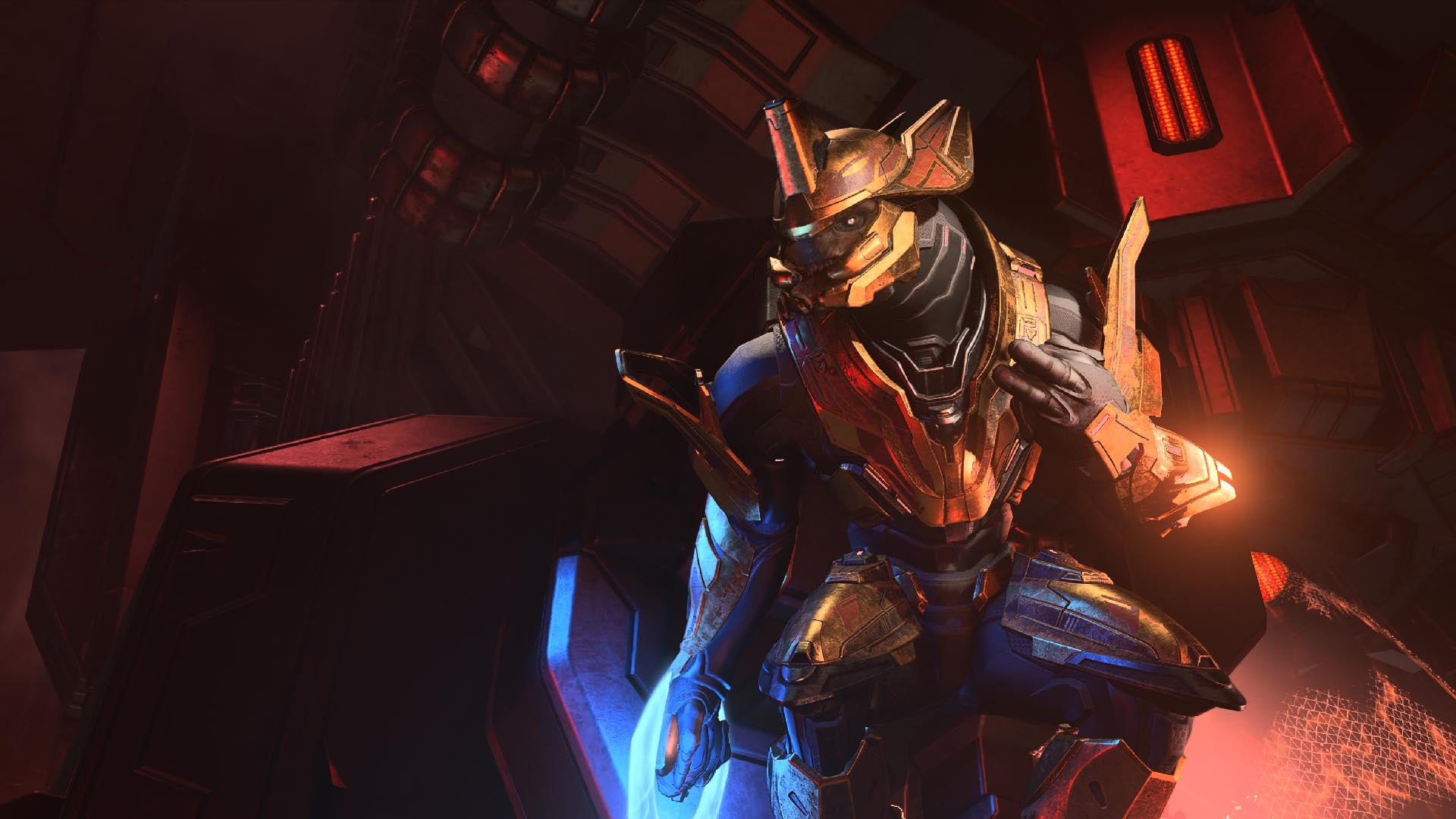
That’s right: Halo Infinite is rife with boss fights. To the game’s credit, none are mere bullet sponges, as you’d find in comparable modern first-person shooters like Far Cry, Borderlands, Wolfenstein, or even Halo 5. Every single boss requires a distinct strategy…that, again, would be far more manageable with a partner. The invisible Elite who can kill you in a hit or two wouldn’t be so frustrating if you could have one person around to set up a threat sensor and another posted in the corner to scope out headshots. The duo of turret-wielding Brutes wouldn’t be such a pain if you could, funny idea here, fight them two-on-two rather than one-on-two.
There’s also little emotional weight to these encounters, deflating the tension of each showdown. Halo Infinite’s batch of villains are a dour bunch, and not because they’re all hellbent on galactic domination. (OK, maybe a little bit because they’re hellbent on galactic domination.) Microsoft’s embargo agreement once again restricts how much, or who specifically, I can talk about here. But I’ll generally note that no villain is any more or less interesting than your typical one-dimensional tyrant.
Escharum, the big bad who’s plastered all over Halo Infinite’s trailers, key art, and other pre-release marketing materials, is the most egregious offender. The mentor of Atriox, Escharum assumes the mantle of responsibility for leading the Banished on the ring’s surface. But his entire modus operandi seems to be about nothing more than beating up Chief and taking his lunch money for the sheer purpose of seeing who’s stronger, like an insecure kid who leans way too hard into insipid machismo.
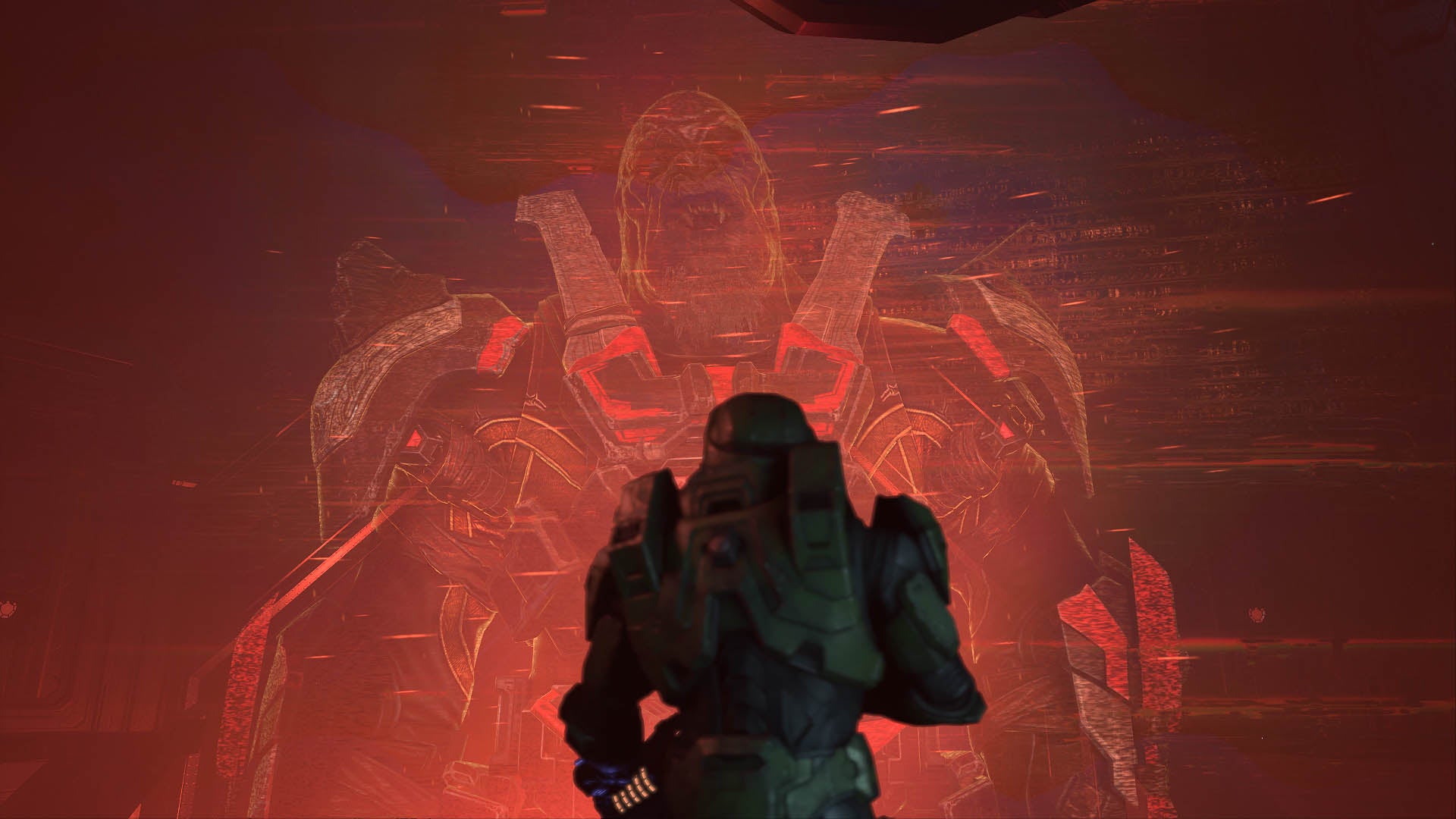
At one point, Escharum goes so far as to orchestrate a progressively tense series of arenas made out of reclaimed UNSC bases just…because? For reasons? It feels strange and petty, and also makes little logistical sense. Despite playing out on various floors of a towering Covenant structure, all of these outposts are set up on top of suspiciously Earth-looking mounds of sediment. And then there’s the matter that Escharum, supposedly a seasoned military commander, actively condemns hundreds of troops to certain death in pursuit of what’s effectively a pissing contest. For a game that’s otherwise so attentive to the details, this sequence came across as totally out of place, as little more than a stopgap between story beats. (My tangible takeaway is that I now really hope Infinite someday adds a revived iteration of Firefight, Halo’s legacy horde mode.)
I kept expecting some revelation, some shocking late-game twist, to come along and justify Escharum’s whole deal. It never did.
Infinite’s most memorable set piece isn’t one of its biggest. No, it’s one of its smallest: a mausoleum of whispered recordings, each a Cortana speech from Halos past. In a singular hushed-tone moment, Halo Infinite shows how, at its best, it can be both so grand and so intimate. Somewhere along development, 343 Industries wisely recognised that Halo Infinite could never escape the legacy of its predecessors, so it wholeheartedly embraced them.
Last year, at a July 2020 digital showcase meant to drum up buzz for the Xbox Series X, 343 Industries pulled back the curtain on Halo Infinite’s campaign, which was scheduled for release that holiday season. The blowback was swift and fierce. Much of the critique centered on what folks considered flat textures, as immortalised in a viral freeze-frame of a low-resolution Brute character model, teasingly dubbed “Craig” by the community. (Halo Infinite’s current campaign build now has a tongue-in-cheek Easter egg referring to Craig.)
Within a month, 343 delayed Halo Infinite and brought on Halo veteran Joe Staten to take the reins on developing the campaign. Chris Lee, Infinite’s creative lead, left the project soon after, with Bloomberg noting that his role was “sidelined” in the wake of Staten’s onboarding.
It was, in short, a messy time, but publicly at least, 343 Industries is hewing to the line that Infinite likely wouldn’t have been a complete disaster even if it hadn’t changed course in response to public reaction. In a recent interview with Eurogamer, Staten noted how “[Halo Infinite’s core design] decisions were made long before I arrived … we just spent a year doubling down on what was already great about the campaign and tried to make it even better.”
I haven’t the faintest clue how the campaign seen in last year’s showcase would’ve been received, whether it’d shape up as stellar as Infinite has or would’ve totally missed the mark, as so many vocal observers predicted with confidence. (For what it’s worth, I’m on record saying the initial debut looked pretty good!) I don’t know how the current form of Infinite will be received by newcomers, either, since it does seem to assume at least a moderate understanding of series knowledge on the part of the player. I don’t know if longtime fans will love it, or if any widespread adulation will be drowned out by cynics who end up regarding Infinite as little more than a cash-grab walk down memory lane.
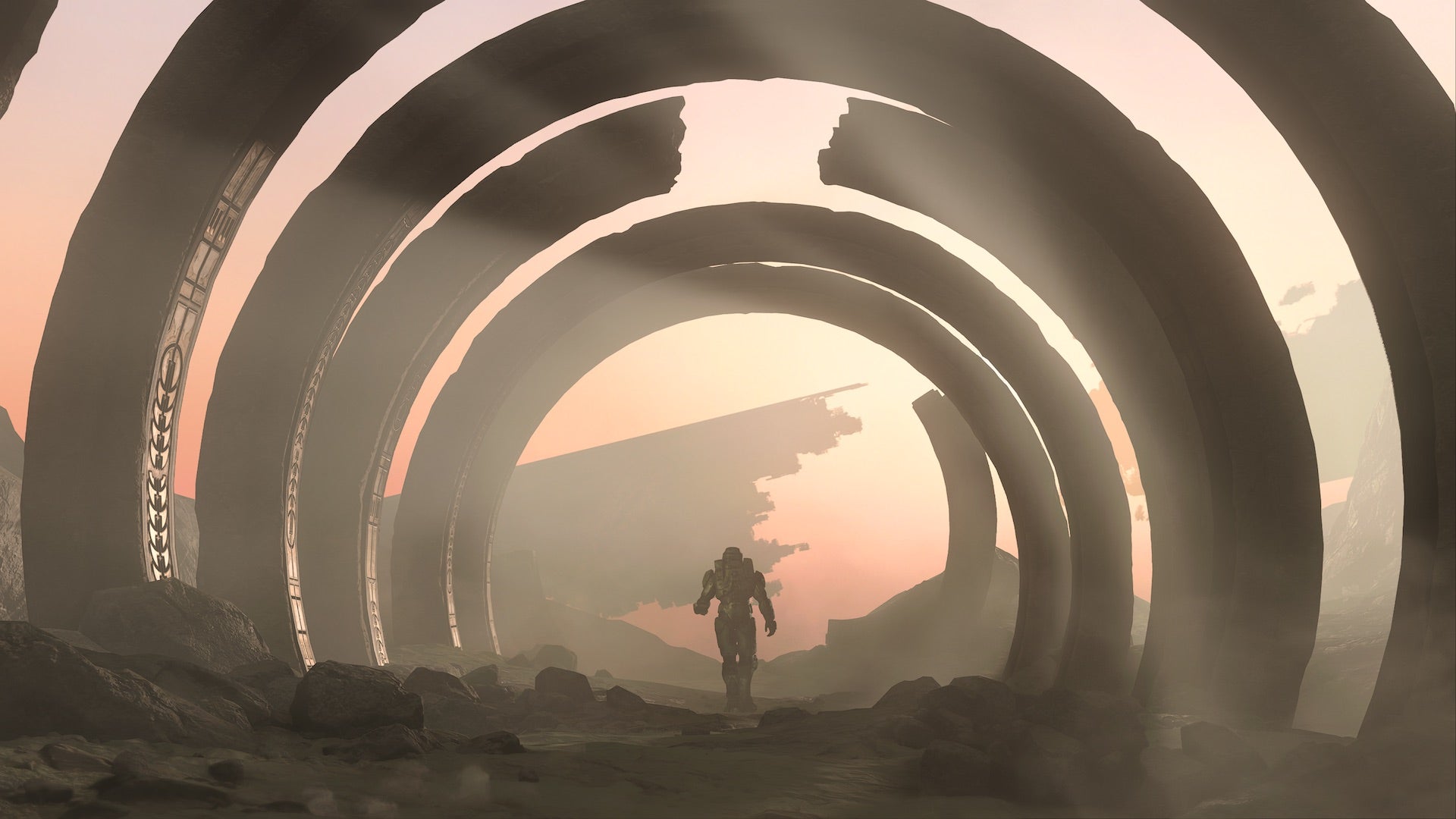
I do know this: As a longtime Halo devotee, it is so, so good to be back to a Halo that genuinely feels like a Halo. I’ve been playing these games for, fuck, man, two decades now. Time was, somewhere in the era before (and momentarily after) Halo 5, I could picture myself hitting a point where I was take-it-or-leave-it on the series. Now? Absolutely not.
How do you even consider Halo Infinite in totality? I’m not sure that you do, not least because 343 Industries has stated that Infinite isn’t the end of a lengthy development process but the start of an ever-evolving game. (See: seasonal model, incoming cooperative and creative modes, the barest wisps of rumoured story expansions.) Master Chief loves to prattle on about “finishing the fight.” But the fight never ends. And if Halo Infinite is what we get as a result? Bring it on.
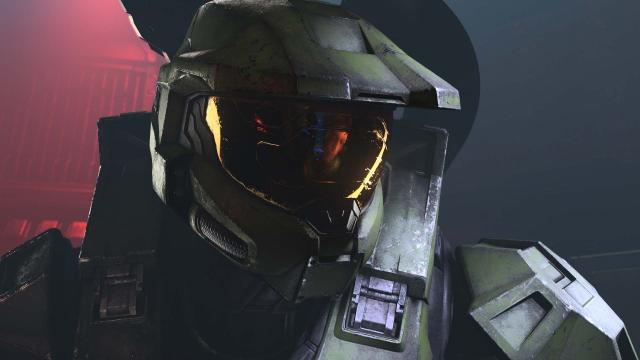
Leave a Reply